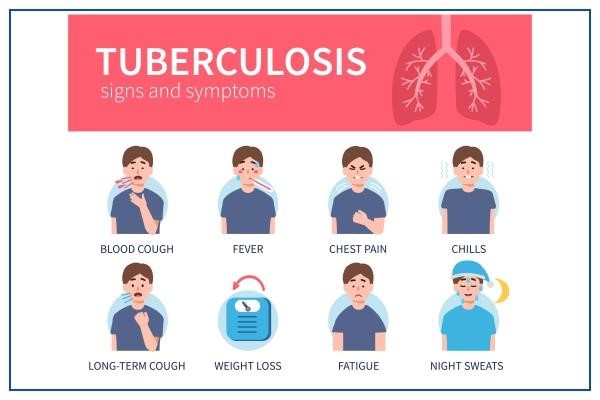WORLD TUBERCULOSIS DAY
Context
- On World TB Day 2023, Prime Minister Narendra Modi addressed the One World TB Summit.
World Tuberculosis Day
- World Tuberculosis Day is observed each year on March 24 to create and raise awareness about tuberculosis (TB) and work to completely eliminate this disease.
History
- Robert Koch in 1882 identified the bacterium that causes tuberculosis, Mycobacterium tuberculosis.
- This was a significant breakthrough in the fight against the disease, which had been one of the leading causes of death for centuries.
- In 1982, the International Union Against Tuberculosis and Lung Disease (IUATLD) launched World TB Day on March 24, to coincide with the 100th anniversary of Koch's discovery.
Theme
- The first World TB Day was observed in 1983, with the theme "Defeat TB: Now and Forever". Since then, the day has been marked every year with a new theme that focuses on a specific aspect of the global fight against TB.
- The theme for World Tuberculosis Day 2023 is "Yes! We can end TB!" which aims to inspire and encourage high-level leadership, increased investments, faster uptake of new WHO recommendations, adoption of innovations, accelerated action, and multisectoral collaboration to fight the Tuberculosis epidemic.
Significance of World TB Day
- World TB Day is an opportunity to unite the global population in the fight against the disease.
- The day is also an opportunity to focus on the progress made in the prevention and treatment of Tuberculosis and to advocate for more funding and research to combat the disease.
TB
- Tuberculosis (TB) is a bacterial infection spread through inhaling tiny droplets from the coughs or sneezes of an infected person.
- It mainly affects the lungs, but it can affect any part of the body, including the tummy (abdomen), glands, bones and nervous system.
- TB is a potentially serious condition, but it can be cured if it's treated with the right antibiotics.

How many TB cases are detected each year in India?
Number of Cases
- Although India continues to be the largest contributor to global TB cases, there has been a decline in the number of cases in 2021.
Reporting
- Reporting of TB cases also improved in 2021 – although it didn’t reach the pre-pandemic levels, it bounced back from the lows seen during the first year of the pandemic, according to the Global TB Report 2022.
TB Incidence
- The incidence of TB – new cases detected through the year – reduced by 18% in 2021 over the 2015 baseline, dropping to 210 cases per lakh population as compared to 256 cases per lakh population.
- The incidence of drug-resistant TB also went down by 20% during the period from 1.49 lakh cases in 2015 to 1.19 lakh cases in 2021.
India’s TB Burden in the world
- India accounts for 28% of all TB cases in the world, according to the Global TB Report 2022. There were 21.3 lakh cases detected in 2021 as compared to 18.05 lakh cases in 2020. The numbers are still lower than the 24.04 lakh cases reported before the pandemic in 2019.
- A survey conducted across 20 states pegged the incidence at a higher 312 cases per lakh population.
What is India’s TB elimination target?
Elimination Target
- Although the elimination of Tuberculosis is one of the sustainable development targets to be achieved by 2030 by the world, India has set a target of 2025.
Reporting Target
- The national strategic plan 2017-2025 sets the target of India reporting no more than 44 new TB cases or 65 total cases per lakh population by 2025. The estimated TB incidence for the year 2021 stood at 210 per lakh population.
- Achieving this target is a big task as the plan had envisaged an incidence of only 77 cases per lakh population by 2023.
Mortality Rate
- The program also aims to reduce the mortality to 3 deaths per lakh population by 2025.
- The estimated TB mortality for the year 2020 stood at 37 per lakh population.
Catastrophic Costs
- The plan also aims to reduce catastrophic costs for the affected family to zero.
- However, the report states that 7 to 32 percent of those with drug-sensitive TB, and 68 percent with drug-resistant TB experienced catastrophic costs.
Reduction in number of new cases
- The goals are in line with the World Health Organisation’s End TB strategy that calls for an 80% reduction in the number of new cases, a 90% reduction in mortality, and zero catastrophic cost by 2030.
What is being done to try to achieve this target?
To achieve the TB elimination target of 2025, the government has taken several steps including looking for cases actively among vulnerable and co-morbid populations, screening for them at the health and wellness centres, and calling on the private sector to notify all TB cases.
Nikshay portal
- An online Nikshay portal has been set up to track the notified TB cases.
CB-NAAT and TureNat
- The pandemic has led to improved access to more accurate molecular diagnostic tests like CB-NAAT and TureNat which were also used to test for Covid-19.
- At present, there are 4,760 molecular diagnostic machines available, covering all districts of the country.
- In addition, 79-line probe assay laboratories and 96 liquid culture testing laboratories have been set up for the diagnosis of multi and extremely drug-resistant TB.
Universal Drug Susceptibility Test
- The government has also implemented a Universal Drug Susceptibility Test, meaning that antibiotic susceptibility of the mycobacterium is determined for all newly diagnosed cases.
- Earlier, the patients were started on first-line treatment and were tested for drug resistance only if the therapy did not work. Conducting a drug susceptibility test at the outset ensures that the patients are given antibiotics that will work for them from the get-go.
Decentralized DR TB treatment services
- These services are offered through 162 Nodal DR-TB Centres and 614 District DR TB centres across the country.
Pradhan Mantri TB Mukt Bharat Abhiyan (PMTBMBA)
- Launched by the Ministry on 9th September 2022 for community support to TB patients with the objective to provide people with TB with additional nutritional, diagnostic and vocational support.
Nikshay Mitras
- Last year, the government also launched a community engagement program where Nikshay Mitras can adopt TB patients and provide them monthly nutritional support.
- So far, 71,460 Nikshay Mitras have adopted about 10 lakh TB patients under the programme.
Important Article on TB: https://www.iasgyan.in/daily-current-affairs/tuberculosis
What are the improvements in treatment protocols?
- Newer drugs such as Bedaquiline and Delamanid for the treatment of drug-resistant TB have been included in the government’s basket of drugs provided to free TB patients.
- These oral drugs can replace the injectable kanamycin that was associated with serious side effects like kidney problems and deafness.
- These new drugs have also been included in the new National List of Essential Medicines that gives the government power to regulate their market price as well.
- Researchers have also been studying shorter three- and four-month courses of anti-tubercular drugs, instead of the existing six-month therapy. Anti-tubercular drugs have to be taken for six months to over two years depending on the susceptibility of the mycobacterium.
- Long duration of treatment results in people dropping out in between, increasing their likelihood of them developing drug-resistant infections later.
Vaccines and Trials
BCG Vaccine Review
- Nearly 100 years after the existing BCG vaccine was developed, researchers are on the lookout for newer ways of preventing tuberculosis infection.
- The BCG vaccine uses a weakened form of TB bacteria to train the immune system. Although it can protect against severe forms of TB like the ones in the brain, the protection is not very good against the most common form of TB in the lungs. It offers limited protection to adults; it doesn’t prevent people from getting the infection or re-activation of a latent infection.
Immuvac Trials
- Trials are underway to test the effectiveness of a vaccine called Immuvac, which was initially developed to prevent leprosy, in preventing TB. The vaccine developed using Mycobacterium Indicus Pranii has antigens – the portions of a pathogen against which antibodies are developed – similar to those of leprosy and TB bacteria.
VPM1002
- Researchers are also testing the vaccine candidate called VPM1002, which is a recombinant form of the BCG vaccine modified to express the TB antigens better. This results in better training of the immune system and protection against TB.
BCG vaccine booster shot
- Researchers are also studying whether the existing BCG vaccine booster shot should be given to household contacts of a person with active tuberculosis.
Closing Remarks
- It is time to encourage new treatment initiatives that appear to be highly active against TB (including MDR TB) and require shorter periods of treatment. MDR TB (Multi drug resistant TB) accounts for about 1% of new TB cases.
- India needs to scale up Genexperts (tests to diagnose drug-resistant TB). Though treatable, the treatment process takes up to 2 years and is considerably more expensive and toxic.
- There is a lack of an honest assessment of the TB situation in India. Instead of sticking to the message of ending TB by 2025, the focus should be more on the progress made so far and keep a check on what is not working and come up with a plan and strategy. Without transparent accounting, there is no way to make the improvements that are needed.

KUNO NATIONAL PARK
Context
- The Kuno National Park in Madhya Pradesh has welcomed its first four cubs born to one of the cheetahs translocated to India on the 17th of September 2022 under Project Cheetah.
About
- Kuno National Park is a national park and Wildlife Sanctuary in Madhya Pradesh.
- It derives its name from Kuno River. It was established in 1981 as a wildlife sanctuary in the Sheopurand Morena districts.
- In 2018, it was given the status of a national park. It is part of the Khathiar-Gir dry deciduous forests ecoregion.
- In the 1990s, it was selected as a possible site to implement the Asiatic Lion Reintroduction Project, which aimed at establishing a second lion population in India.
- The main predators occurring in the protected area are Indian leopard, Southeast African cheetah, jungle cat, sloth bear, dhole, Indian wolf, Indian jackal, striped hyena, and Bengal fox.
https://newsonair.gov.in/News?title=Kuno-National-Park-in-Madhya-Pradesh-welcomes-four-Cheetah-cubs&id=458451

NEW INDIA LITERACY PROGRAM
Context
- TheGovernment has launched a new Scheme namely, New India Literacy Programme.
Details
- This new Scheme is a Centrally Sponsored Program.
- It has been launched with financial outlay of over one thousand crore rupees for implementation during the financial year 2022-23 to 2026-27.
- The scheme aims to cover a target of five crore non-literates in the age group of 15 years and above.
- The beneficiaries under the scheme are identified through door to door survey on Mobile App by the surveyors in the States and union Territories.
- The non-literate can also avail the benefit of the scheme through direct registration from any place through mobile app.
https://newsonair.gov.in/News?title=New-India-Literacy-Programme-launched-to-cover-target-of-5-crore-non-literates-in-age-group-of-15-years-and-above&id=458461

HOKKAIDO
Context
- An earthquake measuring 6.1 on the Richter scale struck Japan's northern island of Hokkaido.
About

https://newsonair.gov.in/News?title=Earthquake-of-6.1-magnitude-strikes-Japan%26%2339%3bs-northern-island-of-Hokkaido&id=458379
BASIC CUSTOMS DUTY EXEMPTED ON DRUGS AND FOOD SPECIALLY IMPORTED TO TREAT RARE DISEASES
Context
- The Central Government has exempted all drugs and Food for Special Medical Purposes imported for personal use for treatment of all Rare Diseases from the basic customs duty.
Details
- The Government has fully exempted Pembrolizumab (Keytruda) used in the treatment of various cancers from basic customs duty.
- The exempted drugs and Food are listed under the National Policy for Rare Diseases 2021.
- To avail the exemption, the individual importer has to produce a certificate from the Central or State Director Health Services or the Civil Surgeon of the district.
READ ABOUT RARE DISEASES: https://www.iasgyan.in/daily-current-affairs/national-policy-for-rare-diseases-2021-7
https://newsonair.gov.in/News?title=Govt-exempts-basic-customs-duty-on-drugs-and-food-specially-imported-to-treat-Rare-Diseases&id=458499






